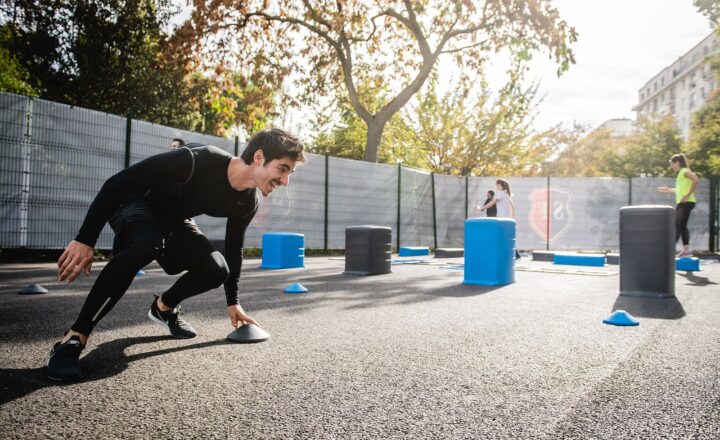How to Build Muscle Without a Gym: Home Exercises for Real Gains
November 14, 2024

In today’s busy world, finding the time to hit the gym can be a challenge. Whether due to scheduling conflicts, financial constraints, or simply personal preference, the idea of working out at home is becoming increasingly appealing. The great news is that you can certainly build muscle without setting foot inside a gym. In this article, we will explore effective home exercises, nutrition tips, and strategies to help you achieve real gains from the comfort of your own home.
1. Understanding Muscle Building Without a Gym
Building muscle is fundamentally about resistance training, which is the act of exerting your muscles against resistance to stimulate growth. You don’t necessarily need fancy machines or weights to build muscle; in fact, bodyweight exercises can be extremely effective.
The key factors for muscle growth, also known as hypertrophy, involve:
- Progressive Overload: This is the gradual increase of stress placed on the body during training. It can be achieved not only by adding weights but also by increasing repetitions, changing angles, and varying tempo.
- Proper Nutrition: Fueling your body with the right nutrients is essential for muscle recovery and growth. This includes adequate protein intake, healthy fats, and carbohydrates to sustain energy levels.
- Recovery: Muscles grow during recovery, not during the workout itself. Ensure you are getting enough sleep and rest days to allow your muscles to repair and strengthen.
These principles form the foundation of your muscle-building journey, and they can easily apply to a home workout routine.
2. Effective Home Exercises for Muscle Building
When training at home, it’s important to have a variety of exercises to target different muscle groups effectively. Here’s a breakdown of various functional exercises to help you maximize your muscle gains:
Upper Body Exercises
– Push-Ups: A classic exercise that targets the chest, shoulders, and triceps. It can be modified for different levels of difficulty.
– Dips: Using a sturdy chair or bench, dips target the triceps and lower chest. Make sure to keep your elbows close to your body for better focus on the muscle.
– Pull-Ups/Chin-Ups: If you have a pull-up bar, these exercises are excellent for developing both the back and biceps. Use resistance bands for assistance if needed.
Core Exercises
– Planks: Engage your whole core with variations of planks from standard to side planks and even plank jacks for added challenge.
– Russian Twists: Great for obliques, you can do them with a weight (like a full water bottle) or without.
– Mountain Climbers: This exercise works the core while also getting your heart rate up.
Lower Body Exercises
– Squats: Bodyweight squats help build strength and size in the legs. Consider adding single-leg variations to increase the difficulty.
– Lunges: Forward or backward lunges target the quads and glutes. Use a chair for support if you need balance.
– Glute Bridges: Focus on the glutes while engaging the hamstrings for a well-rounded leg workout.
Full Body Workouts
– Burpees: This high-intensity move works everything from your legs to your shoulders and develops cardiovascular fitness as well.
– Bodyweight Circuit Training: Combine any of the above exercises into a circuit for a comprehensive workout.
Combining these exercises into a weekly workout plan using progressive overload means you’ll achieve maximum results without stepping foot in a gym.
3. Creating Your Home Workout Routine
Developing a structured workout routine is essential for tracking your progress. Here’s a simple guide to creating your personalized home workout schedule:
– Frequency: Aim to work out 3-5 times a week, focusing on different muscle groups each session.
– Duration: Each session should last anywhere from 30 to 60 minutes. This is enough time to warm up, exercise, and cool down effectively.
– Exercise Selection: Include 8-10 total exercises, ensuring you target the upper body, lower body, and core.
– Rest Intervals: Take 30-60 seconds rest between sets and 1-2 minutes between exercises to optimize recovery and maintain intensity.
Here’s a sample weekly workout plan:
– Day 1: Upper Body (Push-Ups, Dips, Pull-Ups)
– Day 2: Lower Body (Squats, Lunges, Glute Bridges)
– Day 3: Core (Planks, Russian Twists, Mountain Climbers)
– Day 4: Active Recovery (Yoga or Stretching)
– Day 5: Full Body Circuit (Burpees, Bodyweight Circuits)
Consistency and structure will be your allies in achieving muscle gains at home.
4. Fuel Your Body: Nutrition Tips for Muscle Building
Your workout efforts will be ineffective without adequate nutrition. Here are some dietary tips to ensure you’re providing your body with the essential nutrients needed for muscle growth:
– Protein Intake: Aim for 1.2 to 2.2 grams of protein per kilogram of body weight daily. Opt for lean sources such as chicken, fish, legumes, eggs, and dairy.
– Healthy Fats: Include sources like avocados, nuts, and olive oil to support hormonal balance essential for muscle growth.
– Complex Carbohydrates: Consume whole grains, fruits, and vegetables to fuel your workouts and recovery. Consider the timing of your carbs around workouts for maximum energy.
– Hydration: Stay hydrated before, during, and after workouts. Dehydration can hinder performance and recovery.
This nutrient-dense approach helps create a conducive environment for muscle growth. Remember, food is fuel!
5. Tracking Your Progress and Staying Motivated
Tracking your progress is crucial in maintaining motivation. Here are some practical ways to document your muscle-building journey:
– Fitness Journal: Record your workouts, reps, and sets regularly. Note how you feel after workouts to identify patterns.
– Progress Photos: Take before and after pictures to visualize your physical changes over time.
– Measurements: Measure your arms, chest, waist, and legs to see physical changes that scales may not show.
– Set Goals: Develop both short-term and long-term goals, like increasing reps or adding a new exercise.
Maintaining motivation can sometimes be a challenge, so find a workout buddy or community online, join challenges, and celebrate small wins along the way.
Conclusion
Building muscle without a gym is not only possible but can be incredibly rewarding. With a well-structured routine, proper nutrition, and a commitment to progress, you can achieve real gains at home. Remember to stay consistent, patient, and flexible in your approach. Every small effort counts towards reaching your fitness goals. Now that you know how to build muscle without a gym, it’s time to take action and transform your body right from your own home!







